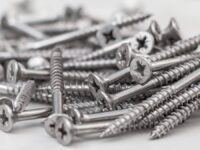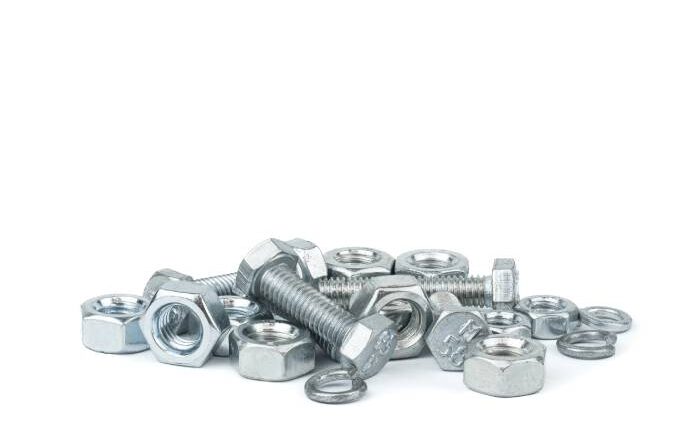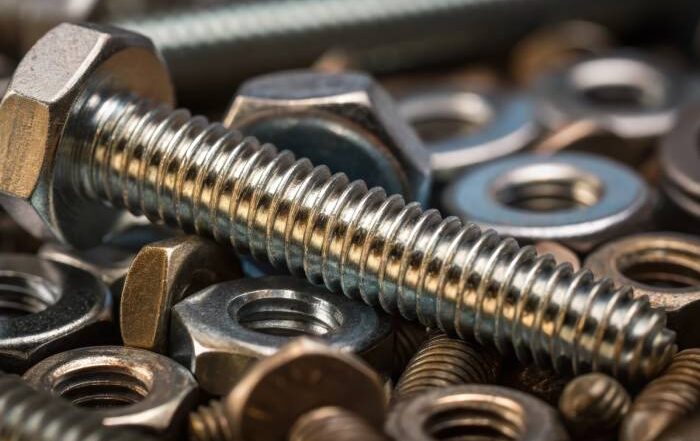
Screws are probably the most common stainless steel fasteners that are used in every industry. They are vital to all projects and equipment. We have a basic guide on screws and the types of screws.
What are screws made of?
Screws are made from different types of material. The most common type of material for screws is stainless steel due to its inexpensive material. Other materials include copper, aluminum, and titanium. Screws are coated for protection and strength. The coating can include copper, zinc, and ceramic coating.
How to use screws?
First, you need to choose the right screw for your application. Certain factors come into place when choosing a screw, such as its durability, weight, cost, and type of project you are working on.
Stainless steel screws are inexpensive and work best for all applications. If you need extra durability against corrosion, copper screws are your best bet. For lightweight, aluminum is a good choice. Titanium is both lightweight and durable, but it is costly.
Next, you need to consider the materials you are working with. Wood screws are for joining pieces of wood such as furniture, for example. You need a screw that will withstand the material of your project. If you are working with outdoor materials, you need screws with a coating that can withstand harsh elements.
Grab a screwdriver or drill and put on gloves and safety gear if needed. Make a plot hole and begin screwing until the screw is tight if you are using a screwdriver. Don’t use excessive force or you might damage the material being used. If you are using a drill be careful to use the right speed to avoid overheating or burn marks. A clamp can be used to avoid slips.
Material Composition of Screws
Regarding screws, there isn’t a universally applicable solution. The success of your project might be significantly impacted by the type of material you choose for your screws. Although stainless steel is a common choice, screws are available in various materials, each with specific benefits and recommended applications. We’ll look at the most popular screw materials in this section: brass, aluminum, stainless steel, and steel.
Steel Fasteners
Composition: Carbon steel, an iron and carbon alloy, is commonly used to make steel screws. The screw’s strength and hardness are influenced by its carbon content.
Benefits: Steel screws are renowned for their sturdiness and strength. They can be used for various tasks, such as construction and woodworking.
Use Cases: Steel screws work great indoors for tasks where rust isn’t a significant issue. Additionally, they find employment in machinery and automotive applications.
Screws Made of Stainless Steel
Composition: An iron alloy with at least 10.5% chromium is used to make stainless steel screws. This chromium concentration provides excellent corrosion resistance.
Benefits: Stainless steel screws are perfect for outdoor, marine, and coastal applications because of their exceptional resistance to rust and corrosion. Over time, they keep their appearance.
Use Cases: External construction, marine projects, and any application where moisture exposure is anticipated are among the many uses for stainless steel screws.
Brass Screws
Composition: Brass screws is mainly made up of copper and zinc in different proportions. The alloy becomes stronger when zinc is added.
Benefits: Brass screws can be used indoors or outdoors due to their corrosion resistance. Their golden appearance is quite appealing.
Use Cases: In situations where the screws will be visible, as well as for decorative and ornamental projects, brass screws are frequently selected.
Titanium Screws
Composition: Aluminum alloys, which can have different compositions to produce various qualities, are used to make aluminum screws.
Benefits: Aluminum screws resist corrosion and are lightweight. They are frequently employed in situations where losing weight is essential.
Applications: Aluminum screws are used in the electronics, automotive, and aerospace industries and in circumstances where weight is an issue.
Copper Screws
Composition: Copper is the primary component of copper screws due to its exceptional electrical conductivity and resistance to corrosion.
Benefits: Since conductivity is crucial in plumbing and electrical applications, copper screws are frequently used. They provide strong resistance to corrosion.
Use Cases: Electrical equipment, wiring, and plumbing systems frequently contain copper screws.
Specialized Screw Materials
Apart from standard materials such as brass, aluminum, steel, and stainless steel, specialty materials are made to fit certain project specifications. These include plastic and titanium screws, each with special qualities and benefits.
Titanium Screws
Composition: Titanium alloys, renowned for their remarkable strength-to-weight ratio, are used to make titanium screws. These alloys may also have other elements, such as aluminum or vanadium.
Benefits: Titanium screws are extraordinarily robust and light. Even in challenging conditions, they have a high level of corrosion resistance. Titanium is also biocompatible, making it appropriate for aeronautical and medical applications.
Use Cases: Titanium screws are preferred in aerospace, medical implants, and high-performance racing cars where weight reduction is essential.
Polymer Screws
Composition: The thermoplastic polymers nylon, polypropylene, and polycarbonate are commonly used to make plastic screws.
Benefits: Plastic screws have good chemical and corrosion resistance. They are perfect for electrical applications because they are non-conductive. Moreover, they are reasonably priced and lightweight.
Use Cases: Plastic screws are frequently utilized in places where metal fasteners would not be appropriate, such as electronics, food processing machinery, and automobile interiors.
Material Qualities
Various screws are made of different materials, each with unique qualities that meet project requirements in terms of strength, resistance to corrosion, and other areas.
Strength: Due to their remarkable resilience, titanium and steel screws are appropriate for heavy-duty applications. Despite their power, brass and aluminum screws are typically utilized in less demanding situations.
Corrosion Resistance: Screws made of brass, plastic, and stainless steel are corrosion-resistant; stainless steel is particularly effective in abrasive settings. Contrarily, coatings or finishes may be necessary for steel screws to stop corrosion.
Weight: Weighing less is essential in industries like aerospace and automotive, where titanium and aluminum screws are popular due to their low weight.
Conductivity: Due to their high conductivity, copper screws can be used in electrical applications. Since plastic screws are non-conductive, they are the better choice when electrical insulation is needed.
Finishes and Coatings
Improved screw durability largely depends on coatings and finishes, particularly in harsh settings. Typical finishes and coatings consist of:
Zinc Coating: Also known as galvanized screws, zinc-coated screws offer protection that helps ward off corrosion. They are frequently employed in maritime and outdoor settings.
Ceramic Coating: Screws with a ceramic coating are highly resistant to corrosion and can withstand harsh industrial and maritime environments.
Nickel plating: Suitable for both ornamental and functional purposes, nickel-plated screws offer a decorative finish and resistance to corrosion.
Choosing the right screws for your projects requires an understanding of the characteristics and benefits of different materials and the influence of coatings and finishes. You can guarantee the durability and success of your projects by selecting the screw material and finish that best suit your needs.
Types of Screws
There are several kinds of screws, each intended for a particular use. Understanding the distinctions between wood and machine screws and the importance of thread kinds can significantly influence the outcome of your tasks.
Wood Screws Versus Machine Screws
Machine screws: Usually used to join metal components, these screws feature consistent threads. They are frequently used in automotive, electronics, and mechanical applications and require pre-tapped holes or bolts for correct installation.
Wood Screws: Wood screws are perfect for connecting wood to metal or wood to wood because of their tapered, self-tapping shape. They are frequently used in building and woodworking, and in most circumstances, they don’t require pre-drilled holes.
The materials you’re dealing with and the particular needs of your project will determine whether you choose machine screws or wood screws. Wood screws are made for undertakings using wood, whereas machine screws are appropriate for applications involving metal on metal.
Types of Thread
Thread types are important because they affect how screws work and which jobs they work best for. Below are a few typical thread types:
Coarse Thread: Coarse threads are more vibration-resistant and have wider spaces between them. They are frequently used with wood and other softer materials and offer an excellent grasp.
Fine Thread: Fine threads are more resilient to loosening by vibrations because they have smaller spaces between them. Typically, metal-to-metal applications are where they are employed.
Twin-fast threads: These screws feature a coarse line at the top and a fine cable at the bottom, representing two distinct thread types on one screw. This design makes it possible to fasten various fabrics quickly and securely.
It is crucial to understand thread types to choose the appropriate screw for your job. Fine threads are more suitable for metal tasks, but coarse threads work great with wood. Twin-fast cables are user-friendly and versatile.
Tips for Using Screws
Correct screw usage necessitates several important actions, from choosing the appropriate screw for the task to using the proper installation methods. The following advice will help you maximize the use of your screws:
Choosing the Proper Screw
Assessing the materials you’re fastening and the application’s requirements is the first step in selecting the appropriate screw. Consider elements like head type, length, diameter, and screw material. For advice, consult the manufacturer’s suggestions and industry norms.
Preparation
Making sure you’re ready is essential to a safe and reliable connection. Sometimes pre-drilling holes are necessary to keep wood from splitting or to make room for the size of the screw. Before beginning your project, gather all required equipment and supplies.
Implementation Methods
For a satisfactory result, proper installation practices are essential. Take these steps:
- Place the power tool bit or screwdriver firmly into the screw’s head.
- Place the screw in line with the material’s surface or the pre-drilled hole.
- To stop the screw from falling out of place, apply light pressure.
- Turn the screwdriver or power tool clockwise to insert the screw into the fabric.
- Steer clear of overtightening, which might strip the screw’s threads or harm the substance. Set the torque as necessary.
- Ensure that the screw head of a countersunk screw is flush with the material’s surface.
Tools Required
The design of the screw’s head determines the kind of screwdriver or power tool you require. Slotted, Torx, Phillips, and hexagonal heads are typical possibilities. To avoid slipping or damaging the screw head, ensure the tool you’ve picked is compatible with the type of screw.
Safety Precautions
As with any task involving screws, safety must always come first. Take into account these safety precautions:
- When using power tools, wear the proper safety gear, such as gloves, safety glasses, and hearing protection.
- Maintain a well-lit and orderly work area to help avoid mishaps.
- When handling pointed or sharp screws, exercise caution.
- To prevent needless risks, keep tools and screws stored safely and well-organized.
Typical Errors and Problem Solving
Even though screws are simple to work with, there are times when they can lead to typical blunders that will make your project less successful. You can prevent these mistakes by being aware of them:
- Excessive Force:
When this is done during screw tightening, it can result in many problems, such as breaking the screw, ruining the material, or stripping the threads. Attain the required tightness by gradually applying pressure using an appropriate torque setting. - Using the Wrong Type:
Weak connections and poor performance can arise from choosing the incorrect type of screw for your application. Always match the screw to the material and project specifications to guarantee a tight fit. - Ignoring Pre-Drilling:
If you omit the pre-drilling phase, the wood may split, or the screw may break, especially if the material is dense or hardwood. When required, take the time to pre-drill holes. - Mixing Metals:
To stop galvanic corrosion, keep items made of different metals apart, and don’t combine screws with them. To ensure compatibility, stick to materials with similar qualities. - Troubleshooting:
While screw problems might be annoying when working on a project, many issues have simple fixes: - Stripped Screws:
Use a rubber band or a specialist screw extractor tool if the screw’s head or threads become stripped and challenging to turn. To remove the screw, place the rubber band or extractor over it, press firmly down, and rotate counterclockwise. - Screws Not Holding:
It may be necessary to use larger screws or anchors to provide additional stability if screws are not holding firmly in their intended holes. Make sure the spot is the right size and depth, and if needed, think about choosing a more substantial material.
Screws are handy and adaptable fasteners that are employed in a wide range of sectors. Understanding the many kinds of screws, the importance of thread types, and their proper usage can significantly impact the outcome of your endeavors.
Following the guidelines in this blog and avoiding typical blunders will enable you to operate with screws with confidence and create strong, long-lasting connections for your projects. Success when fastening wood, metal, or other materials depends on using the correct screws and procedures. Contact Marsh Fasteners for more information about types of screw materials and investing in the best fasteners for your project.



